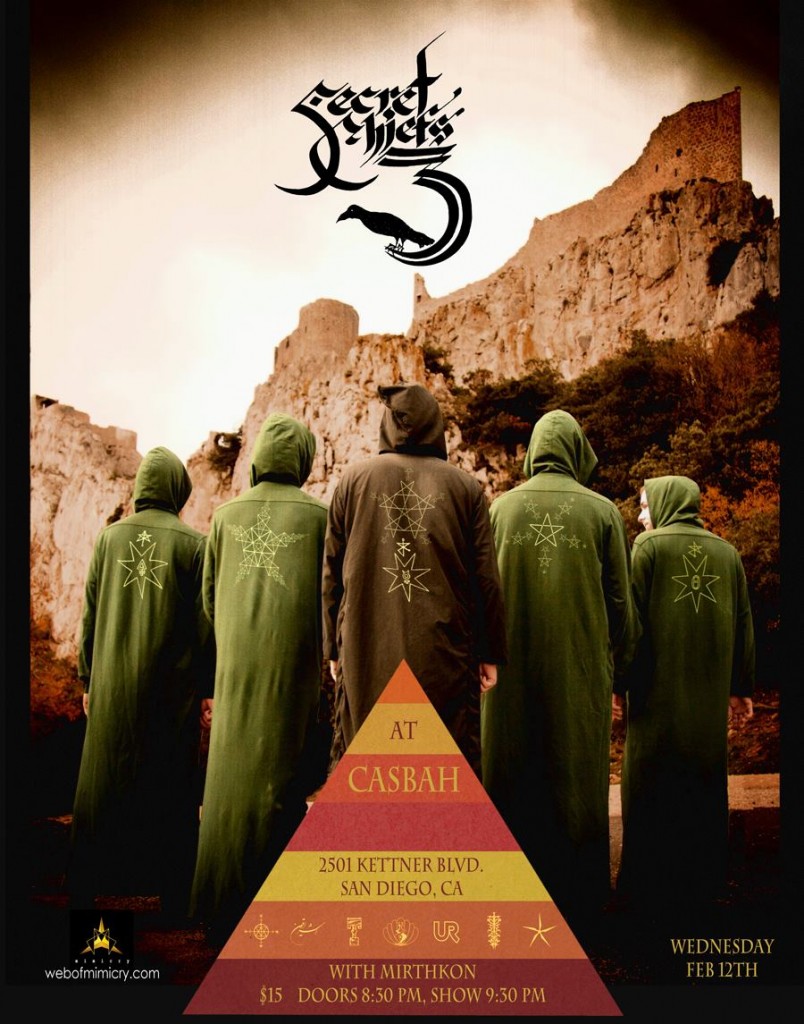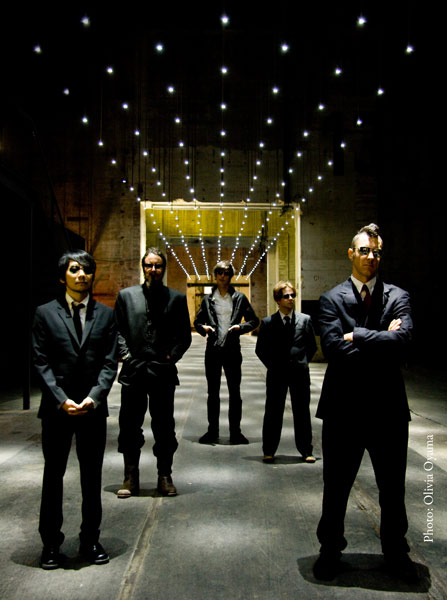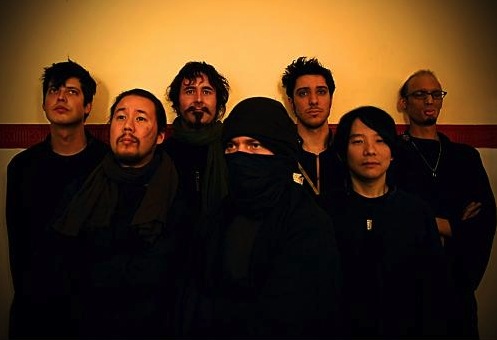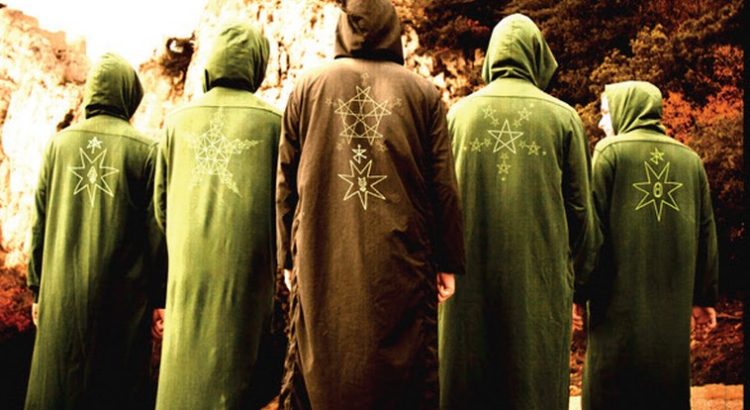
[ Secret Chiefs 3 recently toured California in support of their latest album: Book of Souls: Folio A. My correspondent to the south, Mike Stone, wrote this review of the show and provided an audio recording. ]
• • •
Secret Chiefs 3 and miRthkon at the Casbah San Diego, CA February 12th, 2014
by Mike Stone
Clubs in San Diego tend to shy away from a lot of the more challenging acts that are touring, these days. I typically find myself making the trek north, to Hollywood, or in the best case, Orange County to see bands I might consider “Avant Garde,” experimental or just out of the ordinary. Secret Chiefs 3 is one such band, and I have driven many miles to see them many times. This night, I was lucky enough to catch them locally, in a club that many consider legendary for San Diego, the Casbah, an intimate dive directly under the flight path of approaching airliners that roar by, just above the building.
Opening for Secret Chiefs 3 was miRthkon, a band I had seen online and heard on the Other Rock Show, a radio show from London on Resonance 104 FM, but I was not prepared for what they presented, right from the start.
miRthkon label themselves as “Oaklandish Chambercore,” and I suppose that were you to attempt to pigeonhole this ensemble in a concise label that would be the best anyone could do. The band consists of two guitarists, Travis Andrews and Wally Scharold, two horn players, Carolyn Walter and Jamison Smeltz, bass guitar by Matt Lebofsky and drums by Peter Valsamis. Nearly everyone provided vocals. miRthkon had me grinning ear-to-ear almost immediately with a high-energy offering: a twisting and turning ride with hooking interplay between the horns and the guitars. The infectious energy bled from the stage. Band members appeared to be somewhat in their own worlds, and rightfully so. This is not the kind of show to be looking for puffery from a “front-man,” this was serious music, requiring concentration and some sight-reading by the band members. (I’ve been told that Valsamis only had two shows with the band as a fill-in, so his performance was even more impressive, considering.)
miRthkon were not just impressive, their music was infectious fun, reminiscent of bands like Estradasphere, mixing genres like a deck of cards: chamber music and metal, jazz and funk, math-rock and fusion. There was so much going on! One attendee likened them to Zappa, not too off the mark, really. It was obvious to me that I will have to spend an awful lot more time exploring their catalogue, as well as their live DVD. One 45-minute set simply wasn’t enough to grasp what they really put out. To anyone who needs to be challenged by the music they listen to, miRthkon gets my highest recommendations.
Secret Chiefs 3 has long been a favorite of mine; being a fan of Mr. Bungle, it’s a natural conclusion, since the band began with three core members of that group: Trey Spruance, Danny Heifetz and Trevor Dunn. The band has several incarnations though, with an ever-revolving collection of amazing players, they appear almost like separate bands from tour to tour. I’ve seen them a total of six times now, and almost every instance has been markedly different from the last.
This night the lineup consisted of Ches Smith (Trevor Dunn’s Trio Convulsant, Charming Hostess) on drums, Toby Driver (Kayo Dot) on bass and some keyboards, Matt Lebofsky pulling double duty tonight on guitars and keyboards, Timba Harris (Estradasphere) on violin, trumpet and guitar and, of course, Trey Spruance on guitar, keys and several other guitar-like instruments that I shall refrain from labeling, as I’m unsure which was which.
Conspicuously absent from the stage was any vocal microphone. Not a single one to afford awkward banter or clichéd pleas for website visits. Vocals are a rarity in the SC3 catalogue, a typically un-necessary addition, as the music ranges from venerable covers of soundtrack composers of yesteryear to fusions of surf-rock and middle-eastern rhythms or stylistic mash-ups of klezmer, classical music and death metal. There is typically so much going on that there is little need for lyrical content.
The band approached the stage in hooded robes, all white, except for Spruance’s, which was brown. Each robe had it’s own variance of a design that include stars and cryptic-looking symbols. Their deep hoods precluded much eye contact with each other or the members of the audience, adding an air of mystery to the presentation.
Full show audio below courtesy of Archive.org:
Starting the set with “Danse Macabre” composed in 1874 by Camille Saint-Saëns, this was obviously not your typical rock show. Next up was “the Seven” and “Balance of the 19”, two of what I can only call eastern fusion songs, with their off-kilter rhythms and interesting structures, really somewhat of an SC3 signature in recent years.
Fourth in the set was “Exodus,” a soundtrack piece that brings images of majesty and memories of spaghetti-westerns from the sixties, certainly one of their most recognizable covers. The restraint of the musicians in service of the song was palpable but never awkward, yet they still brought a modern flavor to the arrangement.
Restraint would soon give way to exploration and channeling, as they launched into “Tistrya” and “Observance of the Word: Vajra,” both favorites of mine.
“Vajra” encompasses tricky and disjointed parts intersected with free-jazz style improvisation and lots of visual and sonic communication between band members. The song really shows off the capabilities these accomplished musicians possess. Ches Smith seems almost taken over by the rhythms and energies of these songs, often appearing to be out of control, sometimes throwing phantom punches at his cymbals, standing and weaving like a boxer reeling from hard punches during drum breaks. Improvised maniacal incursions separate intense and powerful body sections of this gem. Timba Harris commanded the stage with the violin, driving the improvised sections through the aforementioned free-jazz darkness. Spruance provided the “color” through his parts, all the while dancing and turning to and fro, certainly lost in the atmosphere of the song. This seems as though it must be a favorite of the band, as well, given the autonomous freedom afforded to all within the structure. It has been different in every incarnation of the band, as well as from performance to performance.
From the aggressively free “Vajra,” they brought the tone back down, once again, to a level of conservative compositional reserve with “Sophia’s Theme,” almost a palette cleanser. Encompassing elements of soundtrack music and mellow surf-rock, this song was a perfect set-up for the following song.

“Toccata” combined spooky cathedral organs with crunchy metal guitar, grandiose violin leads and fast, punk/metal drumming with high energy and a fevered conclusion.
Up next was “Engagement of the Sword: Combat for the Angel,” a selection from the release “Book M,” which is certainly a great starting point for anyone unfamiliar with the band’s material. This is a rhythmic drone, in a way, again dissected with improvisational excursions throughout. Here, I really started to notice how free Ches Smith was with his approach to the drums, playing outside and exploring variance after variance of the groove, punctuating each instance with fills and “outside playing.” I could see that each member really had to watch or listen for the subtle cues; they seem to thrive while being kept “on their toes.”
From the album “Traditionalists,” the following three songs, presented as an unabbreviated medley, are reminiscent of their earliest styles: highly experimental and noisy, at times. “RFID Slaverider,” “Codex Alimentarius,” and “Zombievision 2012” served to remind me what first attracted me to this band besides it’s affiliation with Mr. Bungle: unbridled experimentalism. Executed with meticulous placement of parts, the musicians really demonstrated the strength of memory. So many parts, so many different sounds to produce with only five people!
Up next was “Radar,” composed by Bernard Herrmann for the classic science fiction movie, “Day the Earth Stood Still,” a contemporary interpretation for the five-piece “rock band” format. Again, SC3 in their regard for composers past, have shared with us something worth revisiting, though under a new light. Though they have afforded certain looseness from the original, orchestral recording from 1951, the translation is faithful and exhilarating.
Flourishes of color from cymbals and an underlying, ominous tone from Matt Lebofsky’s keyboards then led into the high-energy “Saptarishi.” An exciting up-tempo groove with interjected oddball accented bridges lead to a series of traded solo sections. Here, Ches Smith really went into free mode, once again appearing as though he was taking things too far, only to show us all he was in control all the while. Punk infused with jazz, or jazz infused with punk? I don’t care. This is good music.
“Labyrinth of Light” gave yet another nod to the “surf-rock” style, complete with spring-reverb dive bombs on guitar and jumping organ sounds to a straight forward pulse, combining to produce an “epic” and huge ride, culminating in a crash and burn ending.
This was to be the one obligatory moment for the show. Feigning the end of the show, the band left the stage bathed in applause from the intimate crowd, only to come back only moments later. Recently a certain friend pointed out the absurdity of the walk-off and “encore” that every band seems to do every show, and ever since, it has seemed a little silly. I suspect that even some of the band members, themselves, weren’t quite sure why this was necessary. Perhaps this is a tradition that will someday fade out, an unnecessary appendage like the human tail.

The encore began with “The Stars and Stripes Forever” John Phillip Sousa’s march. Lovingly recreated in a five-piece format, it brought a little admiration to something I certainly have overlooked for as long as I can remember.
The coup de grâce of the evening, however, was my favorite live song of Secret Chiefs 3, “The Brazen Serpent.” There is no studio version, as of yet, and I suspect this is due to the improvisational chaotic nature of the song. It just might not translate well through the sanitary processes of recording in studio. It is a blistering song with a difficult count (as near as I can tell, it’s in 15, but I’m a terrible counter) and it provides each member of the band an opportunity to really stretch out and show off a bit. It was as intense as any live song I can remember. This was the song I most wanted to hear and see, and it was no disappointment. The intensity built and built while teasing over and over that “this could be the end!” only to jump back into the chaos, once more and with greater fervor. When the conclusion was finally reached, the release was met with an explosion of admiration from the audience. Really, the most fitting song to end the show. I could hear many in the audience firing off expletives in disbelief.
One of the great things about the Casbah is that the small size affords meeting the musicians after the show much more plausible affair. One young fan waited eagerly to meet with Trey, carrying with him what appeared to be an incredibly well crafted kalimba (thumb-piano) with literally hundreds of tines. The tines were laid out in a configuration that appeared to be microtonal in nature. It was an electric instrument, like a bastard child of a third-world instrument and a keyboard with four levels of keys. Spruance was visibly excited by the concept of this instrument, showing the other band members and talking intently about the possibilities of such an instrument. This all reminded me, once again, why Secret Chiefs 3 is one of my favorite bands: the excitement of creation and exploration is alive and well in this band. There are still people out there who are trying to make something new, something different, and who are also keenly aware of the artists of the past that the mainstream seems to have cast aside.
Great music, great venue. Great night.
• • •
[ Mike Stone is a musician who exists in Southern California, and has a red telephone on his desk that connects him directly to Demise O. He is working with the very first entirely online and international faction of the Immersion a Composition Society, the Interroclef Lodge (Interroclef.bandcamp.com) ]
